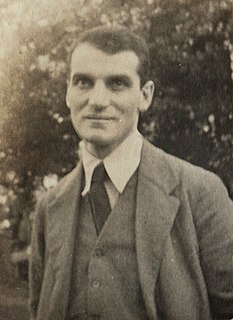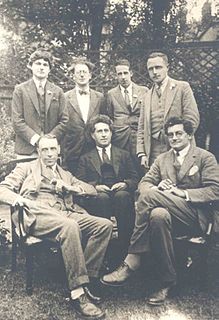
Aldous Leonard Huxley was an English writer and philosopher. He wrote nearly fifty books—both novels and non-fiction works—as well as wide-ranging essays, narratives, and poems.

The Doors of Perception is a book by Aldous Huxley. Published in 1954, it elaborates on his psychedelic experience under the influence of mescaline in May 1953. Huxley recalls the insights he experienced, ranging from the "purely aesthetic" to "sacramental vision", and reflects on their philosophical and psychological implications. In 1956, he published Heaven and Hell, another essay which elaborates these reflections further. The two works have since often been published together as one book; the title of both comes from William Blake's 1793 book The Marriage of Heaven and Hell.

Brave New World is a dystopian social science fiction novel by English author Aldous Huxley, written in 1931 and published in 1932. Largely set in a futuristic World State, whose citizens are environmentally engineered into an intelligence-based social hierarchy, the novel anticipates huge scientific advancements in reproductive technology, sleep-learning, psychological manipulation and classical conditioning that are combined to make a dystopian society which is challenged by only a single individual: the story's protagonist. Huxley followed this book with a reassessment in essay form, Brave New World Revisited (1958), and with his final novel, Island (1962), the utopian counterpart. The novel is often compared to George Orwell's Nineteen Eighty-Four.

Richard Aldington, born Edward Godfree Aldington, was an English writer and poet, and an early associate of the Imagist movement. He was married to the poet Hilda Doolittle (H.D.) from 1911 to 1938.

Lady Ottoline Violet Anne Morrell was an English aristocrat and society hostess. Her patronage was influential in artistic and intellectual circles, where she befriended writers including Aldous Huxley, Siegfried Sassoon, T. S. Eliot and D. H. Lawrence, and artists including Mark Gertler, Dora Carrington and Gilbert Spencer.

George Woodcock was a Canadian writer of political biography and history, an anarchist thinker, an essayist and literary critic. He was also a poet and published several volumes of travel writing. In 1959 he was the founding editor of the journal Canadian Literature which was the first academic journal specifically dedicated to Canadian writing. He is most commonly known outside Canada for his book Anarchism: A History of Libertarian Ideas and Movements (1962).
The perennial philosophy, also referred to as perennialism and perennial wisdom, is a perspective in philosophy and spirituality that views all of the world's religious traditions as sharing a single, metaphysical truth or origin from which all esoteric and exoteric knowledge and doctrine has grown.

John Middleton Murry was an English writer. He was a prolific author, producing more than 60 books and thousands of essays and reviews on literature, social issues, politics, and religion during his lifetime. A prominent critic, Murry is best remembered for his association with Katherine Mansfield, whom he married in 1918 as her second husband, for his friendship with D. H. Lawrence and T. S. Eliot, and for his friendship with Frieda Lawrence. Following Mansfield's death, Murry edited her work.
Sir Christopher Bruce Ricks is a British literary critic and scholar. He is the William M. and Sara B. Warren Professor of the Humanities at Boston University (US), co-director of the Editorial Institute at Boston University, and was Professor of Poetry at the University of Oxford (UK) from 2004 to 2009. He is the immediate past-president of the Association of Literary Scholars and Critics. He is known as a champion of Victorian poetry; an enthusiast of Bob Dylan, whose lyrics he has analysed at book length; a trenchant reviewer of writers he considers pretentious ; and a warm reviewer of those he thinks humane or humorous. Hugh Kenner praised his "intent eloquence", and Geoffrey Hill his "unrivalled critical intelligence". W. H. Auden described Ricks as "exactly the kind of critic every poet dreams of finding". John Carey calls him the "greatest living critic".

The Perennial Philosophy is a comparative study of mysticism by the British writer and novelist Aldous Huxley. Its title derives from the theological tradition of perennial philosophy.
Literary modernism, or modernist literature, originated in the late 19th and early 20th centuries, mainly in Europe and North America, and is characterized by a self-conscious break with traditional ways of writing, in both poetry and prose fiction writing. Modernism experimented with literary form and expression, as exemplified by Ezra Pound's maxim to "Make it new." This literary movement was driven by a conscious desire to overturn traditional modes of representation and express the new sensibilities of their time. The horrors of the First World War saw the prevailing assumptions about society reassessed, and much modernist writing engages with the technological advances and societal changes of modernity moving into the 20th century.

John William Navin Sullivan (1886–1937) was a popular science writer and literary journalist, and the author of a study of Beethoven. He wrote some of the earliest non-technical accounts of Albert Einstein's General Theory of Relativity, and was known personally to many important writers in London in the 1920s, including Aldous Huxley, John Middleton Murry, Wyndham Lewis, Aleister Crowley and T. S. Eliot.

Men Like Gods (1923) is a novel, referred to by the author as a "scientific fantasy", by English writer H. G. Wells. It features a utopia located in a parallel universe.
Literature of the 20th century refers to world literature produced during the 20th century.

Sinister Street is a 1913–1914 novel by Compton Mackenzie. It is a kind of bildungsroman or novel about growing up, and concerns two children, Michael Fane and his sister Stella. Both of them are born out of wedlock, something which was frowned upon at the time, but from rich parents.

The Gospel of Sri Ramakrishna is an English translation of the Bengali religious text Sri Sri Ramakrishna Kathamrita by Swami Nikhilananda. The text records conversations of Ramakrishna with his disciples, devotees and visitors, recorded by Mahendranath Gupta, who wrote the book under the pseudonym of "M." The first edition was published in 1942.

Horizon: A Review of Literature and Art was a literary magazine published in London, UK, between December 1939 and January 1950. Published every four weeks, it was edited by Cyril Connolly, who made it into a platform for a wide range of distinguished and emerging writers. It had a print run of 120 issues or 20 volumes.

Science, Liberty and Peace is an essay written by Aldous Huxley, published in 1946. The essay debates a wide range of subjects reflecting Huxley's views towards the direction of society at that time. He puts forward a number of predictions, many of which resonate far beyond the time when it was written. A consistent theme throughout the essay is Huxley's preference towards a decentralised society.
Peter Edgerly Firchow was an American literary scholar and educator. He wrote extensively on the relationship between British and German literature of the late 19th and early 20th centuries, and he was a leading scholar of the British writer Aldous Huxley. He served as a faculty member in the University of Minnesota English Department from 1967 to 2008 and as director of the university's Comparative Literature program from 1972 to 1978.

The following bibliography of Aldous Huxley provides a chronological list of the published works of English writer Aldous Huxley (1894–1963). It includes his fiction and non-fiction, both published during his lifetime and posthumously.















